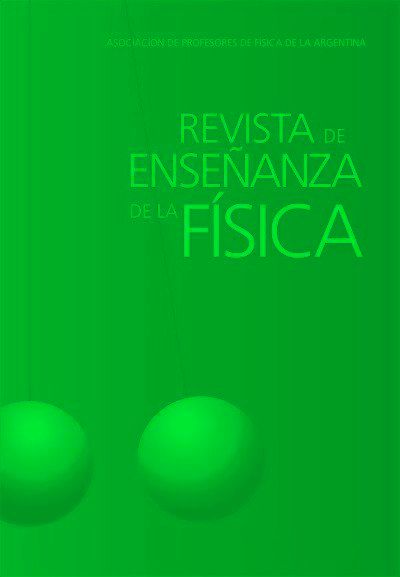The covid-19 challenge: keeping active learning approach to physics instruction in distance learning
DOI:
https://doi.org/10.55767/2451.6007.v33.n2.35319Keywords:
Active learning, General Physics, Remote learning, Interactive lecture demonstrations, PhET simulationsAbstract
This work reports on the classroom experience regarding the teaching of a general physics course for prospective biology and
math teachers. In order to keep the learning cycle of successful active learning teaching strategies, a few of the working sheets
of the teaching strategy Interactive Lecture Demonstrations were adapted as homework assignments based on the use of PhET
simulations. In this approach the in-class work based on peer interactions and experimental setups provided with on-line
graphical representations of well-designed experiments was replaced with the homeworks that used PhET simulations instead
of experimental equipment, while the full classroom social interactions were replaced by remote collaboration of pair of
students. In this work the detail structure of this learning approach is informed, together with the results of three students´
opinion questionaries.
References
Beichner R. (2006). Recuperado de https://www.compadre.org/per/items/detail.cfm?ID=4404.
Benegas, J. y Sirur Flores, J. (2021). How Much is Lost? Measuring Long-Term Learning Using Multiple Choice Tests. Elect.
J. for Res. in Sc. & Math. Ed., 25(1), 93-104.
Benegas, J y Villegas M. (2021). Introducing Pre-Service Math and Biology Teachers to Physics PCK, Journal of Science
Teacher Education. Recuperado de https://doi.org/10.1080/1046560X.2021.1909809.
Freeman, S., Eddy, S. L., McDonough, M., Smith, M. K., Okoroafor, N., Jordt, H., & Wenderoth, M. P. (2014). Active learning
increases student performance in science, engineering, and mathematics. Proceedings of the National Academy of
Sciences, 111(23), 8410–8415. DOI:10.1073/pnas.1319030111.
Hake, R. R. (1998). Interactive-engagement versus traditional methods: A six-thousand-student survey of mechanics tests
data for introductory physics courses. American Journal of Physics, 66, 64–74. DOI:10.1119/1.18809.
Heller, P. & Heller, K. (1999). Cooperative group problem-solving in physics, University of Minnesota. Recuperado de
https://groups.physics.umn.edu/physed/Research/CGPS/GreenBook.html
ISLS (2021). The International Conference on Computer-Supported Collaborative Learning, Recuperado de:
https://www.isls.org/annual-meeting/cscl/
Laws, P.W. (1997). Workshop Physics Activity Guide. Hoboken, NJ: Wiley.
López Tabares, D. (2020), Estrategias didácticas para el uso eficaz de simulaciones interactivas en el aula. Lat. Am. J. Sci.
Educ., 7, 12019.
López Tabares, D. y Orozco Martínez, J. (2017) Clases Interactivas Demostrativas con el uso de simulaciones PhET para
Mecánica en Preparatoria. Lat. Am. J. Sci. Educ, 11(2), 2322-1.
McDermott L.C., Shaffer P.S., and the Physics Education Group at the University of Washington, (2001) Tutoriales para
Física Introductoria. Buenos Aires: Prentice Hall. Traducción de Tutorials in Introductory Physics. Pearson Publishing, Inc.
Meltzer D, y Thornton R. (2012). Resource Letter ALIP–1: Active-Learning Instruction. Physics, Am. J. Phys., 80(6), 478.
PhET (2021). https://phet.colorado.edu/es/simulations/translated/es
Sokoloff D. y Thornton R. (2004) Interactive Lecture Demonstrations. Hoboken, NJ: Wiley.
Sokoloff D. y Thornton R. (2004) Real Time Physics. Hoboken, NJ: Wiley.
Downloads
Published
Issue
Section
License
Copyright (c) 2021 Julio Benegas, Ana Paula Lucero, Myriam Villegas

This work is licensed under a Creative Commons Attribution-NonCommercial-NoDerivatives 4.0 International License.
Aquellos autores/as que tengan publicaciones con esta revista, aceptan los términos siguientes:Los autores/as conservarán sus derechos de copiar y redistribuir el material, bajo los términos estipulados en la Licencia de reconocimiento, no comercial, sin obras derivadas de Creative Commons que permite a terceros compartir la obra bajo las siguientes condiciones:
- Reconocimiento — Debe reconocer adecuadamente la autoría, proporcionar un enlace a la licencia e indicar si se han realizado cambios. Puede hacerlo de cualquier manera razonable, pero no de una manera que sugiera que tiene el apoyo del licenciador o lo recibe por el uso que hace.
- NoComercial — No puede utilizar el material para una finalidad comercial.
- SinObraDerivada — Si remezcla, transforma o crea a partir del material, no puede difundir el material modificado.
- Los autores/as podrán adoptar otros acuerdos de licencia no exclusiva de distribución de la versión de la obra publicada (p. ej.: depositarla en un archivo telemático institucional o publicarla en un volumen monográfico) siempre que se indique la publicación inicial en esta revista.
- Se permite y recomienda a los autores/as difundir su obra a través de Internet (p. ej.: en archivos telemáticos institucionales o en su página web) antes y durante el proceso de envío, lo cual puede producir intercambios interesantes y aumentar las citas de la obra publicada. (Véase El efecto del acceso abierto).










